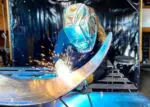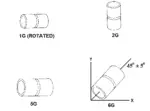Welding is quite a complicated process for those who are new to it. But there are certain areas that can make you go off your head even if you have years of experience. Today, in this blog I am going to tell you one of those crazy areas in welding – welding in the 4F position.
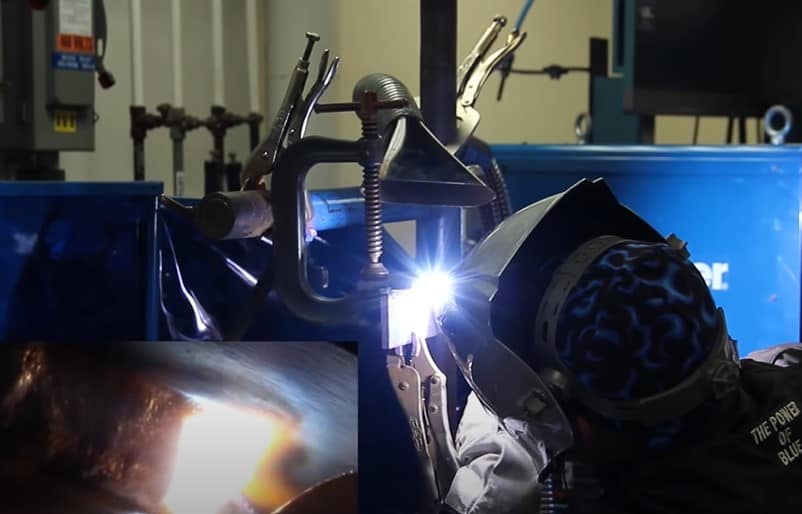
4F is the position in welding where you weld the metal overhead. Thereby, you position yourself underneath the weld. As working in the position is complicated, a welder needs to take certain precautions and be alert during the process.
You are here to learn everything about 4F and hence, I will tell you everything from the basics starting from what is 4F to the tricks to do it smoothly…
Dive in to know more….
Is the 4F position in welding complicated?
Imagine you doing the welding directly above your head. Do you think it will be a pretty scene? Of course, the process is complicated and you need to undergo years of practice to do the weld without feeling nervous.
Unlike other positions in welding, 4F requires you to arch your neck for as long as you are welding, in a way that can give tension to your neck muscles. It is not easy to do a risky business like welding right above your head.
Welding requires a lot of your attention including a good visibility of the weld and keen eye to detect any flaw while doing it. While for the rest of the positions maintaining these are easier as the base metals are placed in a level below the welder’s nose, but for 4F this is not the case.
The situation is a little complicated you see… And due to this, a welder needs to take certain precautions that can help him to have a trouble free experience while welding in 4F. Of course, a welder who is proficient in 4F welding is therefore considered to be an expert and they are in great demand.
Is 4G the same as 4F in welding?
A common doubt among those who are learning about welding – What is the difference between 4F and 4G or are they the same?
Well…..they are the same alright but there is a slight difference as well. 4F denotes the overhead position of welding fillets while 4G denotes the welding of grooves in the same position.
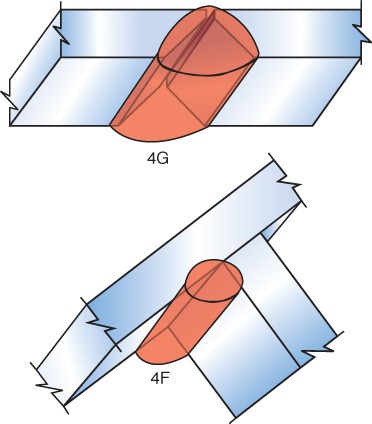
By now you might have understood what exactly ‘4’ denotes. ‘4’ in ‘4 F’ means the position, that is overhead and the letter denotes where it is done or what type it is.
Similarly, other positions are denoted with numbers like 1, 2, and 3. All four together make the four major and commonly used positions in welding.
| 1F | Flat position (Fillet) |
| 2G | Flat position (Groove) |
| 2F | Horizontal position ( Fillet) |
| 2G | Horizontal position (Groove) |
| 3F | Vertical position(Fillet) |
| 3G | Vertical position (Groove) |
| 4F | Overhead position (Fillet) |
| 4G | Overhead position (Groove) |
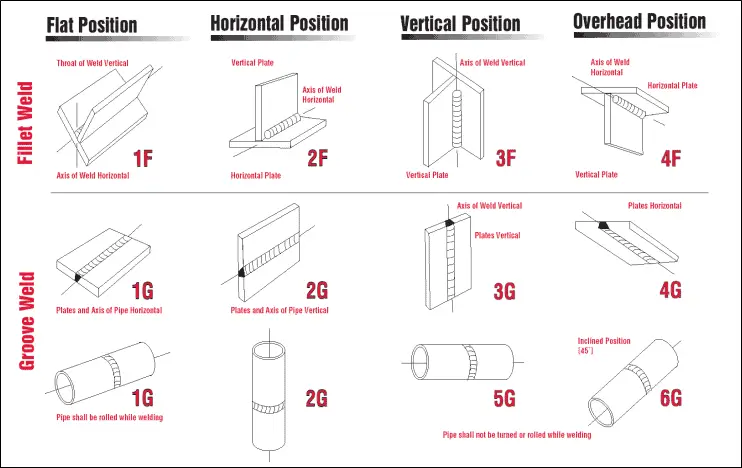
There is also a type of welding called ‘Stud welding’ where a stud made of metal is joined with a metal piece. Positions are there just like in normal welding but instead of 4F/4G it is denoted as 4S.
When to use the 4F position in welding?
The 4F position is called out-of-position of welding or overhead welding to be precise. As the name suggests, this position is not the ordinary way of welding. By now, you are familiar with 4F/4G and how a welder positions himself to do the same.
Well, all these matters in 4G welding as this position is used in fields such as offshore, shipbuilding, pipeline, structural, and in general fabrication that demands construction of huge structures where pieces cannot be moved.
The parts that are used for construction are therefore large ones unlike the other positions in welding. Once they are set, they are to stay like that forever. Thus, 4F/4G plays an important role in these industries.
What are the pros and cons of using welding in the 4F position?
Overhead position of welding is known for advantages that are quite unique to it. They are:
Useful for larger pieces– In the above section I mentioned where 4F welding is primarily used. If you observe, you can understand how these situations specifically demand this position of welding. For example, ships are huge structures whose parts are to be built only in certain specific ways.
Large pieces are to be assembled through welding and can only be done if they are placed above the worker. These pieces therefore are not supposed to be moved once they are initially set in a place. In these situations, 4F or 4G welding positions do the trick.
High demand– Having the technical know-how of 4F welding is a huge advantage for a welder. Either it can be a help for his own works, or it can be of help to others. Moreover, a person having expertise in 4F weld is thereby establishing his thorough knowledge in all other welding positions as well.
As 4F is complicated, a person needs to prove his expertise in other positions before getting certified in 4F. Therefore, having the certificate of having passed the 4F weld test can give the welder an upper hand over others who do not have the same.
Now, for the cons…
Gas loss– A major problem with 4F welding is the huge loss of shielding gas. As the work happens overhead and shielding gas tends to easily flow upwards, the effect of the gas in creating a suitable atmosphere around the area of the weld is not optimal.
For other positions like 1F, 2F or 3F this would never be a problem as the gas tends to stay at least for a few minutes around the area as the welding happens below the level of the welder’s neck. He can therefore have a reach and easily comprehend the required gas flow rate.
Risky business- Of course, 4G welding is risky with the welder all caught up in an awkward position with his face near to the welding area and above his head.
Spatter and molten metal dripping from the weld pool are two major areas that the welder needs to keep an extra eye for. If not careful, this anti-gravity play can cost you your eyesight or beautiful skin.
Difficult– Well, this is quite obvious isn’t it? With the work happening above your head and you giving full concentration in getting a good weld at the same time ensuring no accidents happen is something that is quite arduous. A keen eye together with patience is needed to do 4F welding.
Time taking process– Complicated procedure requires time. To successfully complete 4F weld successfully, you need to take time and do it. Rushing through is never an option for 4F welding. It can only cause trouble.
How to Improve my 4F weld technique?
Yes, 4F welding can give you quite a difficult time. But, following certain tricks you can find your way in 4F welding too…Given below are a few things that can help you rectify the common mistakes that you do while welding in 4G position.
1. Circular pattern welding for good weld profile
A circular movement of the gun can give you tighter weld beads that have enough integrity to hold the base metals together despite the narrow profile. Learn the technique from welders who have enough experience in it.
2. Compensate for the gas lost
One major problem that I have mentioned in cons is the loss of shielding gas. So you have to maintain a higher flow rate throughout the process. The rate of flow needs to be calculated in a way to compensate for this loss of gas.
You may not have an idea when you do 4F welding for the first few times. Either you can go for expert advice or can try through trial and error methods.
3. Maintain low current to keep the heat low
Keep the voltage or amperage low, as the electricity that is generated can result in the heat production that can make the electrode pretty hot resulting in a very hot molten metal pool.
A very liquid pool can make the beads large. Therefore, keep the voltage low, and ensure that the beads are tiny enough to help you finish the process easily.
4. Numerous passes to strengthen the weld
Doing multiple passes over the welds can help strengthen the weld beads. As 4F weld requires the beads to be small and have a narrow profile, it is wise to do over the initial beads to avoid undercuts and fatigue failure when load increases later.
5. Avoid undercut
This is a continuation of the above point. Undercuts are a common flaw that happens in 4F welding. The position being difficult can make it so hard for you to lay the wire and beads correctly. If the process does not happen perfectly there is always a risk of undercutting for 4F weld.
One way to avoid undercuts is by keeping the weld puddle small in size. A small weld puddle can be maintained only if you keep the current low. A better control over the weld puddle along with the optimal movement of the gun can help in having a control over the weld.
By learning the characteristics of the puddle you will know when it will drip, how to stay alert and avoid it from happening.
6. Keep spatter at bay
Too much spatter is a common mistake in 4F weld due to a few factors like long arc length, high amperage and less experience in the technique.
Focus on all these; you can have a much better weld with less spatter trouble. It takes time to master this unusual way of welding and hence I recommend you give it time and patience.
What are the safety tips to keep in mind while welding in the 4F position?
The riskier something is, the more careful you should be. I already mentioned in the cons what are the immediate dangers of 4F welding.
Therefore I am also obliged to tell you the safety precautions that you should take to avoid dangers while welding in this awkward position. Let’s see them, shall we?
1. Low voltage for a spatter less weld
Make sure that the arc length is kept short to avoid spatter. Keep the voltage in such a way that the arc length is low to have a weld with almost no spatter.
Arc length is the gap between the tip of the electrode and surface to be welded. If you keep the arc length short, spatter can be kept at bay.
2. Optimal wire feeding speed to reduce spatter
The speed of wire feeding is something that can result in too much spatter if you are not going at the right speed. For 4F or 4G welding you have to feed the wire at the optimal speed in which you are not too slow or too fast. Find this sweet spot to have a spatter less 4F welding.
Do not be on the notion that finding this perfect speed is a piece of cake. It takes practice and apt understanding of the technique to ultimately decide what the speed that you need is.
3. Maintain speed of the weld to avoid weld pool dripping
Imagine you going slowly with the weld and the molten metal dripping on you. Who would want that huh? For 4F welding the first thing that you have to keep in mind is to not to drag your task and be lazy while welding.
You have to be quick enough so that the molten metal will be set as and when you move the gun. As soon as you finish, you can move away thereby saving yourself from pain and trouble.
4. Small bead size for better weld integrity
High amperage can transfer high heat on the electrode thereby, making the molten pool too fluid. This means the risk of the molten pool to drip is higher and the beads of weld produced will be larger.
Try to keep the amperage less so as to have a short arc length. Make sure your beads are small so that they take less time to dry.
5. Small size of the electrode for small beads
The diameter of the electrode also determines the size of the bead. If the beads are bigger the density will also be high, making fast drying impossible. Always maintain a narrow texture to the beads to have control over them. And by control I mean less spattering.
6. Wear headgear
Wearing headgear is a must for all types of welding. 4F needs you to be extra careful, because you are working below the weld. Risk of the spatter or molten metal falling on your face is high. Face and neck needs to be properly covered.
Buy a headgear from the market after proper research and checking reviews of the product on the internet. Quality and strength should not be compromised for accessories like these as they hold the value of your life.
7. Put on gloves
Make sure you get a good pair of gloves to keep your hand safe from burning. Do not make the mistake of going for low quality ones resulting in an accident that you may regret for the rest of your lifetime.
8. Use ear plugs
As 4G weld happens overhead, do not forget to use earplugs to avoid the spatter from entering your ears. If it happens, it can damage your ears for good. Try to be very alert before and during 4F welding.
How can I pass a 4F weld test without making the common mistakes?
As I said, the credibility that you get as a welder is high if you pass the 4G weld test. However, there are some common mistakes that are committed by the welders while taking the test. Here are a few tips to take note of to avoid these silly blunders…
1. Understanding the basis
4F welding is quite complicated and that is a fact. However, there is often a way to understand the complicated things through some easy analysis. Yes, you heard me right. 4F welding is said to be the upside down version of 1F welding.
If you take little time and think of the positions, you will understand what I am trying to tell you. If this is true, that means the angle, the direction of the gun and most other factors that determine a good 1F weld can also help you in 4F.
But, as the latter is a process that is challenging gravity, there are certain specific things like speed and bead profile that you need to focus on. I have already mentioned ways to improve 4G welding technique.
2. Good selection of accessories
One of the most common mistakes that a welder does during the test is not going for the right equipment and safety measures. Accidents are frequent during tests and can easily cost you a chance as well.
Be sure to get the right accessories before the test. Find the exact fit for gloves, your clothing and helmet. Also, do try them and see if you will be able to do the procedure without any constraints.
3. Find your comfort position
Before the 4G test, while practicing, spend considerable time in finding your suitable position. Not everyone will have the same comfort position. Each person can have his way of facing the weld holding the gun.
Physical characteristics of the person also play a role in this. His height and eye sight matters. So, make sure that you are not trying to copy anyone, rather giving time to find your own way of doing the weld.
4. Ensure safety
Safety matters whether it is a test or live welding. Some major mistakes that are committed are the wrong positioning of one’s feet and inefficient use of electrodes. Both these can cause harm. Molten metal is often at the risk of being too liquid in 4G weld.
Feet and hands are to be covered and positioned correctly in order to avoid probable mistakes. One needs to also show his attentiveness during the test to prove his capability and the very first thing that he can do to make this possible is by keeping him safe and staying alert in case anything wrong happens. Presence of mind is very important for welding.
Did I justify the title of the blog? I hope I did!
Have a good day friends, see you in another one of my welding blogs!





